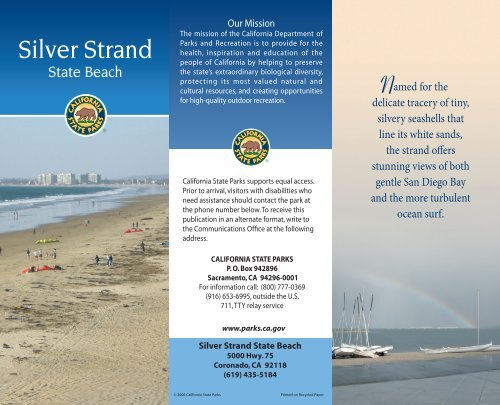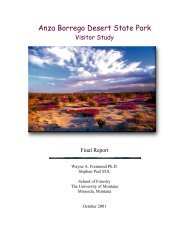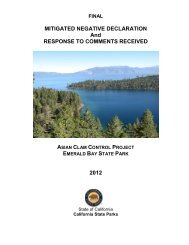Silver Strand Brochure - California State Parks
Silver Strand Brochure - California State Parks
Silver Strand Brochure - California State Parks
Create successful ePaper yourself
Turn your PDF publications into a flip-book with our unique Google optimized e-Paper software.
<strong>Silver</strong> <strong>Strand</strong><br />
<strong>State</strong> Beach<br />
Our Mission<br />
The mission of the <strong>California</strong> Department of<br />
<strong>Parks</strong> and Recreation is to provide for the<br />
health, inspiration and education of the<br />
people of <strong>California</strong> by helping to preserve<br />
the state’s extraordinary biological diversity,<br />
protecting its most valued natural and<br />
cultural resources, and creating opportunities<br />
for high-quality outdoor recreation.<br />
<strong>California</strong> <strong>State</strong> <strong>Parks</strong> supports equal access.<br />
Prior to arrival, visitors with disabilities who<br />
need assistance should contact the park at<br />
the phone number below. To receive this<br />
publication in an alternate format, write to<br />
the Communications Office at the following<br />
address.<br />
CALIFORNIA STATE PARKS<br />
P. O. Box 942896<br />
Sacramento, CA 94296-0001<br />
For information call: (800) 777-0369<br />
(916) 653-6995, outside the U.S.<br />
711, TTY relay service<br />
Named for the<br />
delicate tracery of tiny,<br />
silvery seashells that<br />
line its white sands,<br />
the strand offers<br />
stunning views of both<br />
gentle San Diego Bay<br />
and the more turbulent<br />
ocean surf.<br />
www.parks.ca.govv<br />
<strong>Silver</strong> <strong>Strand</strong> <strong>State</strong> Beach<br />
5000 Hwy. 75<br />
Coronado, CA 92118<br />
(619) 435-5184<br />
© 2006 <strong>California</strong> <strong>State</strong> <strong>Parks</strong> Printed on Recycled Paper
S<br />
ilver <strong>Strand</strong><br />
<strong>State</strong> Beach,<br />
though only about<br />
15 minutes south<br />
of downtown<br />
San Diego, has<br />
a rather wild,<br />
solitary beauty.<br />
The generally<br />
flat beach of this<br />
coastal strand<br />
area, a sand spit<br />
that connects Coronado with Imperial Beach,<br />
stretches for miles. Views from the level<br />
of the beach or alongside San Diego Bay<br />
include Coronado Island, Point Loma, the<br />
Coronado Bridge and the Naval shipyards.<br />
The weather at <strong>Silver</strong> <strong>Strand</strong> is<br />
characterized by warm, dry summers and<br />
cool, wet winters. Summer fog is part of the<br />
Mediterranean climate here. Extremes of<br />
heat or cold are rare, with average maximum<br />
temperatures ranging from near 65 degrees<br />
in January to nearly 78 degrees in August.<br />
PARK HISTORY<br />
Native People<br />
It is believed that humans first came to the<br />
San Diego coast as far back as 20,000 years,<br />
and to inland areas about 12,000 years ago.<br />
The native people were known by many<br />
names, some bestowed by the Europeans,<br />
who called them Diegueños or Mission<br />
Indians. The names preferred by the people<br />
themselves included Kumeyaay (the inland<br />
group), Ipai (the northern group), and Tipai<br />
(the southern group).<br />
These groups were hunter-gatherers who<br />
A typical day at <strong>Silver</strong> <strong>Strand</strong> <strong>State</strong> Beach<br />
also processed acorns from<br />
several species of oaks for<br />
nourishment. They obtained<br />
some foods and obsidian by<br />
trading with native groups<br />
to the east, and the Tipai<br />
people quickly learned to<br />
incorporate Spanish crops,<br />
livestock and tools into<br />
their way of life.<br />
The arrival of Europeans<br />
and Americans ended<br />
the native people’s way of life. Access to<br />
traditional lands and sources of food was<br />
soon restricted or totally lost to them. Over<br />
ensuing years some Indians were “relocated”<br />
to several inland reservations established<br />
around 1875, but thousands more died from<br />
European-introduced diseases to which they<br />
had no immunity. Today’s Kumeyaay Nation—extending<br />
from San Diego and Imperial<br />
Counties to 60 miles south of the <strong>California</strong>-Mexico<br />
border—shares their ancestral<br />
heritage through community outreach and<br />
education.<br />
The <strong>Strand</strong><br />
The Spanish and Mexicans in San Diego<br />
had little interest in the narrow strip of sand<br />
between what they called “San Diego Island”<br />
(Coronado Island) and the mainland, and<br />
in 1846 Pedro C. Carrillo received it as part<br />
of a land grant. In 1885 its resort potential<br />
was first noted. E.S. Babcock and H.L. Story<br />
bought the land, established the Coronado<br />
Beach Company, and built a road and a rail<br />
line over the peninsula. Three years later<br />
Babcock and Story sold the land to John D.<br />
and Adolph B. Spreckels.<br />
In 1931 the Spreckels holding companies<br />
presented 42 acres of the peninsula between<br />
the U.S. Naval Amphibian Base and<br />
the U.S. Naval Communication Station to<br />
the <strong>State</strong> Park Commission, establishing<br />
<strong>Silver</strong> <strong>Strand</strong> Beach <strong>State</strong> Park (now <strong>Silver</strong><br />
<strong>Strand</strong> <strong>State</strong> Beach).<br />
Natural History<br />
The type of vegetation here is called<br />
coastal strand, though much of it has disappeared<br />
due to development. Coastal strand<br />
consists of bare, wind- and spray-whipped<br />
sand and an inland section with only sparse<br />
growth. East of this area, along the highway,<br />
scattered vegetation includes golden bush,<br />
lemonadeberry and sage.<br />
Coastal strand habitat is home to Brandt’s<br />
cormorants, gulls, terns, sanderlings and<br />
loons. The ocean beach and the bay mudflats<br />
are rich feeding areas for shorebirds<br />
<strong>Silver</strong>strand’s east-facing beaches offer stunning views of San Diego Caption Bay.
Beachfront en route camping is very popular.<br />
and other water-oriented birds. The southern<br />
end of the bay is a perfect bird-watching<br />
area, with hundreds of thousands of<br />
birds feeding, nesting or just resting up for<br />
the next leg of their migrations.<br />
Offshore, <strong>California</strong> sea lions and an<br />
occasional school of porpoises may be<br />
seen. On the strand, mammals include<br />
striped skunks, brush rabbits and <strong>California</strong><br />
ground squirrels. Worms, bivalves and sand<br />
crabs are among beach species.<br />
RECREATION<br />
Camping—En route camping (136 spaces)<br />
is available first come, first served for selfcontained<br />
vehicles only. Self-contained<br />
vehicles have built-in enclosed systems that<br />
can hold and store water and tanks that<br />
hold and store sewage. Hookups are<br />
not available. To en route camp at the<br />
park, use parking lot #4 at the north<br />
end of the ocean side and vacate<br />
your parking space by 9:00 a.m.<br />
Fishing—Perch, corbina and yellowfin<br />
croakers are prolific here, and<br />
during the summer, spawning grunion<br />
may be caught on the sand. Anglers must<br />
carry a valid <strong>California</strong> sport fishing license.<br />
Surfing—The two miles of beach break with<br />
white sandy beaches are best at medium to<br />
high tide on a mixed swell. Surfers should<br />
stay north or south of the swimming area.<br />
Swimming/Sailing—The calmer and slightly<br />
warmer water in the bay is ideal for swimming<br />
and sailing.<br />
Kiteboarding—This is a natural place<br />
for kiteboarding. The wind is always five<br />
to ten degrees higher than at San Diego<br />
area beaches. Intermediate to advanced<br />
kiteboarders use the area daily. Kiteboarding<br />
is only permitted at parking lot #1, the<br />
southernmost open parking lot, downwind<br />
of people on the beach or in the water, and<br />
north of the <strong>Silver</strong> <strong>Strand</strong> <strong>State</strong> Beach Natural<br />
Preserve. Kites must not cast shadows over<br />
the beach or any other protected bird habitat.<br />
Picnicking—Ramadas and tables are available<br />
at the beach and bay side picnic areas,<br />
with fire rings on the beach during summer.<br />
Pedestrian tunnels under the freeway allow<br />
access to the bay side picnic area and views<br />
of San Diego Bay.<br />
Aquatic Center—Crown Cove Aquatic<br />
Center is a collaborative effort<br />
between <strong>California</strong> <strong>State</strong> <strong>Parks</strong>,<br />
Southwestern Community<br />
College and the <strong>California</strong><br />
Department of Boating and<br />
Waterways. The facility is<br />
located on the bay side of<br />
<strong>Silver</strong> <strong>Strand</strong> <strong>State</strong> Beach and<br />
offers classes in boating safety,<br />
The endangered<br />
brown pelican<br />
leadership training, CPR, first<br />
aid, swift water rescue, lifeguard<br />
training and more.<br />
Accessible Features<br />
• Picnic areas under shade structures on<br />
the ocean and bay side are accessible.<br />
• Most ocean and bay side areas have<br />
accessible restroom stalls. One outdoor<br />
rinsing shower on the Bay side is<br />
accessible.<br />
• Crown Cove Trail is an accessible .8-mile<br />
loop.<br />
• Two beach wheelchairs are available. For<br />
information, call (619) 435-5184 or check<br />
at the park entrance.<br />
Accessibility is continually improving. For<br />
current accessibility details, call the park, or<br />
visit http://access.parks.ca.gov.<br />
Please Remember<br />
• The front gate opens year round at 8 a.m.<br />
• Camping is available for self-contained<br />
vehicles only.<br />
• Call ahead regarding operating hours,<br />
fees, and conditions, which can change.<br />
• Dogs are allowed only in the parking<br />
lots, on a leash no longer than six feet,<br />
and are not allowed on the beach, in the<br />
tunnels, or on the bay side.<br />
• Fires are allowed only in designated<br />
beach fire rings.<br />
• Glass bottles are not permitted.<br />
• Stingrays sometimes rest atop the sand<br />
in the surf zone. To help avoid being<br />
stung, shuffle your feet as you wade into<br />
the water.<br />
Nearby <strong>State</strong> Park<br />
• Old Town San Diego <strong>State</strong> Historic Park,<br />
in San Diego at San Diego Avenue and<br />
Twiggs Street (619) 220-5422
Two miles of beach break are ideal for surfing.

















